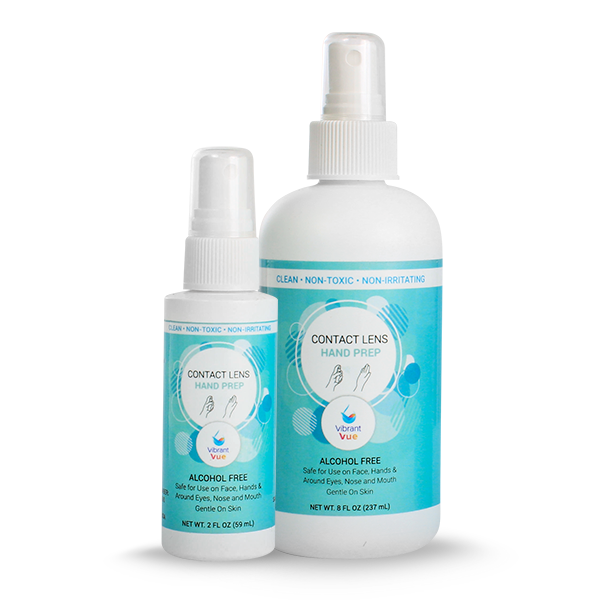Watch Larissa explain how much her life improved with the help of our sMap3D and scleral lenses.
Why Visionary Optics?
“I found Insight Vision Center and it was life-changing. He solved all the issues I had – my lenses are comfortable and they don’t get foggy – from the first pair of lenses that he designed for me [from the sMap3D]. When I look back, I think – WOW, I have come so far & why? Because I can see.” – Larissa


Watch Dr. Quinn discuss the safety of contact lens wear during the time of COVID-19.
Contact Lens Wear in the Time of COVID-19

Explore our new VibrantVue® product line and experience a higher level of contact lens wear and eye care.
VibrantVue® products are approved, tested, and recommended by Optometrists nationwide. These products are only available through your eye doctor. We will ask you to provide us with their name at the time of ordering VibrantVue® products.
Frequently Asked Questions
Scleral contact lenses rest on the sclera (the white of the eye) instead of the cornea (the colored part of the eye). The sclera is less sensitive than the cornea making scleral contact lenses more comfortable than traditional gas permeable lenses. Scleral contact lenses also create a fluid-filled chamber over the cornea. This creates a perfect optical surface and improves vision when compared to traditional soft contact lenses and spectacles. The fluid-filled chamber also nourishes the cornea, making scleral lenses valuable in the treatment and management of many ocular surface and corneal diseases.
We have Eye Care Providers all over the country prescribing our lenses every day. Refer to our Locator Service to find a Prescriber https://www.visionary-optics.com/find-a-location/. If you already have a favorite doctor that is not on our list, let them know they can become a Visionary Optics Provider by shooting us an email to service@visionary-optics.com or calling 877-533-1509.
Scleral lenses are made of a rigid, gas-permeable material unlike soft contact lenses. A list of approved products for cleaning and storage of your lenses can be found in our Handling and Care guide. In addition, lenses should only be filled with preservative-free saline during insertion such as VibrantVue® Scleral Saline. This product is FDA approved, preservative-free, non-buffered, and can be used during insertion or when rinsing your scleral lenses during cleaning.
Yes. Make sure that you are using products that are Non-Abrasive for the best experience with Hydra-PEG coating. Tangible Science, the makers of Hydra-PEG, have provided information about approved solutions on their website: https://tangiblescience.com/care-tips/
Scleral lens supplies can often be purchased through your Eye Care Provider. Always check with your provider on recommended solutions and removal/insertion plungers. In addition, supplies can be found through Menicon America, The Dry Eye Shop, and MyEyeSupply.
Yes. There is limited tear movement under the lens so filling the lens with preservative free saline provides a reservoir of liquid between the lens and the cornea. It’s important that the saline be NON-Preserved and that the bowl of the lens is filled over the top. This will also ensure good insertion. We recommend using FDA-Cleared, single-use vials such as VibrantVue® Scleral Saline.
First, take out your lens and re-insert. Make sure you have FILLED the lens with NON-PRESERVED SALINE and that there are no air bubbles. Make sure you haven’t switched your lenses and placed them in the wrong eyes. If you are on certain medications you may notice a change in how your contact lenses feel. This is usually because some medications impact our tear productions which can be felt when wearing contact lenses. This is especially true with allergy medications. Note how long they have felt this way, when it started and if you have changed anything, particularly your care solutions and medications.
It’s always better to err on the side of caution and give your Eye Care Provider a call when you are using a highly specialized device like scleral contact lenses. However, doing some troubleshooting first and knowing what information to tell your ECP will help them know how to direct you. Call your ECP immediately if you ever experience acute pain, redness, or decreased vision.
Wearing time should be determined by your Eye Care Provider. However, after the initial adaptation period, most people are able to wear their lenses the full day. Refer to the instructions you received or call your Eye Care Provider’s office.
This can vary based on several things, therefore, there is no uniform answer. Some people have eyes that are just “harder” on lenses due to their tear makeup and other eye diseases. It’s paramount that you follow an approved and consistent care regimen. Most people can expect about 1 year of comfortable wear but it’s your responsibility to observe and report any changes to your Eye Care Provider.
Some Vision Plans as well as Medical Plans have a benefit for the management of Keratoconus and other corneal conditions for which scleral lenses are medically necessary. Check with your plan and ask if you have this coverage or if it can be added. Your Eye Care Provider will usually be happy to check the benefits for you when you call and give them the information needed.





